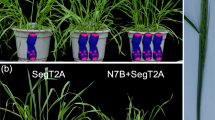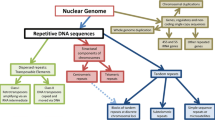Abstract
The EAST protein is a component of nuclear matrix. In the interphase cells, EAST is localized in the extrachromosomal nuclear domain. Increased EAST concentration leads to a change in spatial chromatin structure. However, previously, it was not known whether this protein played any role in the regulation of transcription. This study examines the mechanism of the EAST protein effect on the yellow gene transcription. It was demonstrated that the EAST-dependent repression observed in a model system of the yellow gene could occur not only in the presence of the Su(Hw) insulator sequence but also in the presence of the long terminal repeat sequence of the gypsy retrotransposon. In the LTR, a 92-bp sequence involved in the mechanism of EAST-dependent repression was detected. These results suggest that the found DNA motif is the place of the assembly of a protein complex, which functionally interacts with the EAST protein. This complex either independently suppresses the yellow gene expression in bristles or moves the transgene in the nuclear region with a high concentration of transcription repression factors.
Similar content being viewed by others
References
Wasser, M. and Chia, W., The EAST protein of drosophila controls an expandable nuclear endoskeleton, Nat. Cell Biol., 2000, vol. 2, pp. 268–275. doi 10.1038/35010535
Wasser, M. and Chia, W., The extrachromosomal East protein of Drosophila can associate with polytene chromosomes and regulate gene expression, PLoS One, 2007, vol. 2, e412. doi 10.1371/journal.pone.0000412
Qi, H., Rath, U., Ding, Y., et al., EAST interacts with Megator and localizes to the putative spindle matrix during mitosis in Drosophila, J. Cell Biochem., 2005, vol. 95, pp. 1284–1291. doi 10.1002/jcb.20495
O’Hare, K., Murphy, C., Levis, R., and Rubin, G.M., DNA sequence of the white locus of Drosophila melanogaster, J. Mol. Biol., 1984, vol. 180, pp. 437–455.
Davison, D., Chapman, C.H., Wedeen, C., and Bingham, P.M., Genetic and physical studies of a portion of the white locus participating in transcriptional regulation and in synapsis-dependent interactions in Drosophila adult tissues, Genetics, 1985, vol. 110, pp. 479–494.
Spana, C. and Corces, V.G., DNA bending is a determinant of binding specificity for a Drosophila zinc finger protein, Genes Dev., 1990, vol. 4, pp. 1505–1515.
Scott, K.S., Taubman, A.D., and Geyer, P.K., Enhancer blocking by the Drosophila gypsy insulator depends upon insulator anatomy and enhancer strength, Genetics, 1999, vol. 153, pp. 787–798.
Gause, M., Morcillo, P., and Dorsett, D., Insulation of enhancer–promoter communication by a gypsy transposon insert in the Drosophila cut gene: cooperation between suppressor of hairy-wing and modifier of mdg4 proteins, Mol. Cell Biol., 2001, vol. 21, pp. 4807–4817. doi 10.1128/MCB.21.14.4807-4817.2001
Ghosh, D., Gerasimova, T.I., and Corces, V.G., Interactions between the Su(Hw) and Mod(mdg4) proteins required for gypsy insulator function, EMBO J., 2001, vol. 20, pp. 2518–2527. doi 10.1093/emboj/20.10.2518
Pai, C.Y., Lei, E.P., Ghosh, D., and Corces, V.G., The centrosomal protein CP190 is a component of the gypsy chromatin insulator, Mol. Cell., 2004, vol. 16, pp. 737–748. doi 10.1016/j.molcel.2004.11.004
Golovnin, A., Melnikova, L., Shapovalov, I., et al., EAST organizes Drosophila insulator proteins in the interchromosomal nuclear compartment and modulates CP190 binding to chromatin, PLoS One, 2015, vol. 10, e0140991. doi 10.1371/journal.pone.0140991
Melnikova, L., Shapovalov, I., Kostyuchenko, M., et al., EAST affects the activity of Su(Hw) insulators by two different mechanisms in Drosophila melanogaster, Chromosoma, 2016. doi 10.1007/s00412-016-0596-3
Pirrotta, V., Vectors for P-mediated transformation in Drosophila, Biotechnology, 1988, vol. 10, pp. 437–456.
Savitskaya, E., Melnikova, L., Kostuchenko, M., et al., Study of long-distance functional interactions between Su(Hw) insulators that can regulate enhancer–promoter communication in Drosophila melanogaster, Mol. Cell Biol., 2006, vol. 26, no. 3, pp. 754–761.
Ashburner, M., Drosophila: a Laboratory Manual, New York: Cold Spring Harbor Lab., 1989.
Sambrook, J., Fritsch, E.F., and Maniatis, T., Molecular Cloning: a Laboratory Manual, Cold Spring Harbor: Cold Spring Harbor Lab., 1989, 2nd ed.
Karess, R.E. and Rubin, G.M., Analysis of P transposable element functions in Drosophila, Cell, 1984, vol. 38, no. 1, pp. 135–146.
Rubin, G.M. and Spradling, A.C., Genetic transformation of Drosophila with transposable element vectors, Science, 1982, vol. 218, no. 4570, pp. 348–353.
Spradling, A.C. and Rubin, G.M., Transposition of cloned P elements into Drosophila germ line chromosomes, Science, 1982, vol. 218, no. 4570, pp. 341–347.
Geyer, P.K. and Corces, V.G., Separate regulatory elements are responsible for the complex pattern of tissuespecific and developmental transcription of the yellow locus in Drosophila melanogaster, Genes Dev., 1987, vol. 1, pp. 996–1004.
Siegal, M.L. and Hartl, D.L., Application of Cre/loxP in Drosophila: site-specific recombination and transgene co-placement, Methods Mol. Biol., 2000, vol. 136, pp. 487–495.
Robertson, H.M., Preston, C.R., Phillis, R.W., et al., A stable genomic source of P element transposase in Drosophila melanogaster, Genetics, 1988, vol. 118, pp. 461–470.
Mel’nikova, L.S., Krivega, I.V., Georgiev, P.G., and Golovnin, A.K., Nuclear matrix protein EAST is involved in regulation of transcription of the yellow gene in Drosophila melanogaster, Dokl. Biol. Sci., 2007, vol. 415, no. 1–6, pp. 313–316.
Melnikova, L.S., Krivega, I.V., Georgiev, P.G., and Golovnin, A.K., The nuclear matrix protein EAST affects the transcription of Drosophila melanogaster genes irrespective of the presence of retrotransposon MDG4 sequences, Russ. J. Genet., 2007, vol. 43, no. 12, pp. 1415–1419. doi 10.1134/S1022795407120125
Morris, J.R., Geyer, P.K., and Wu, C.T., Core promoter elements can regulate transcription on a separate chromosome in trans, Genes Dev., 1999, vol. 13, pp. 253–258.
Geyer, P.K., Green, M.M., and Corces, V.G., Reversion of a gypsy-induced mutation at the yellow (y) locus of Drosophila melanogaster is associated with the insertion of a newly defined transposable element, Proc. Natl. Acad. Sci. U.S.A., 1988, vol. 85, pp. 3938–3942.
Parnell, T.J., Viering, M.M., Skjesol, A., et al., An endogenous suppressor of hairy-wing insulator separates regulatory domains in Drosophila, Proc. Natl. Acad. Sci. U.S.A., 2003, vol. 100, pp. 13436–13441. doi 10.1073/pnas.2333111100
Marlor, R.L., Parkhurst, S.M., and Corces, V.G., The Drosophila melanogaster gypsy transposable element encodes putative gene products homologous to retroviral proteins, Mol. Cell Biol., 1986, vol. 6, pp. 1129–1134.
Cremer, T., Kupper, K., Dietzel, S., and Fakan, S., Higher order chromatin architecture in the cell nucleus: on the way from structure to function, Biol. Cell, 2004, vol. 96, pp. 555–567. doi 10.1016/j.biolcel.2004.07.002
Fraser, P. and Bickmore, W., Nuclear organization of the genome and the potential for gene regulation, Nature, 2007, vol. 447, pp. 413–417. doi 10.1038/nature05916
Branco, M.R. and Pombo, A., Intermingling of chromosome territories in interphase suggests role in translocations and transcription-dependent associations, PLoS Biol., 2006, vol. 4, e138. doi 10.1371/journal. pbio.0040138
Chambeyron, S. and Bickmore, W.A., Does looping and clustering in the nucleus regulate gene expression? Curr. Opin. Cell Biol., 2004, vol. 16, pp. 256–262. doi 10.1016/j.ceb.2004.03.004
Chakalova, L. and Fraser, P., Organization of transcription, Cold Spring Harbor Perspect. Biol., 2010, vol. 2, a000729. doi 10.1101/cshperspect.a000729
Xu, Q., Li, M., Adams, J., and Cai, H.N., Nuclear location of a chromatin insulator in Drosophila melanogaster, J. Cell Sci., 2004, vol. 117, pp. 1025–1032. doi 10.1242/jcs.00964
Author information
Authors and Affiliations
Corresponding author
Additional information
Original Russian Text © L.S. Melnikova, M.V. Kostyuchenko, I.V. Krivega, I.S. Shapovalov, P.G. Georgiev, A.K. Golovnin, 2017, published in Genetika, 2017, Vol. 53, No. 9, pp. 1042–1052.
Rights and permissions
About this article
Cite this article
Melnikova, L.S., Kostyuchenko, M.V., Krivega, I.V. et al. Mapping of the gypsy retrotransposon sequence is responsible for the EAST-dependent repression in the yellow gene model system of Drosophila melanogaster . Russ J Genet 53, 988–997 (2017). https://doi.org/10.1134/S1022795417090101
Received:
Accepted:
Published:
Issue Date:
DOI: https://doi.org/10.1134/S1022795417090101




